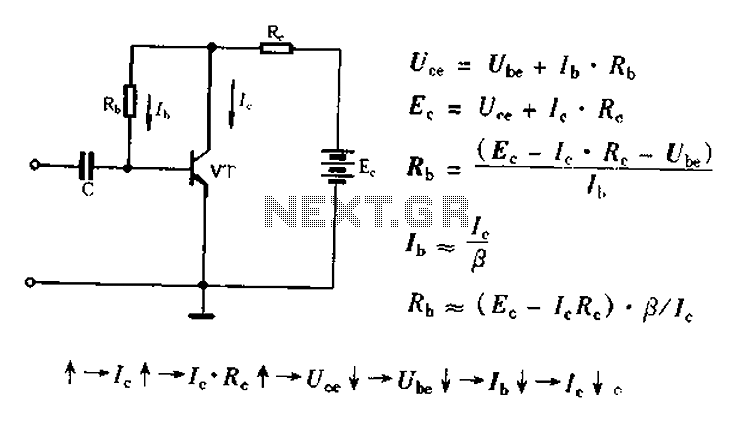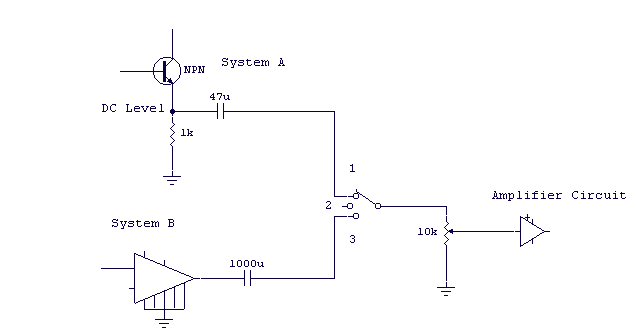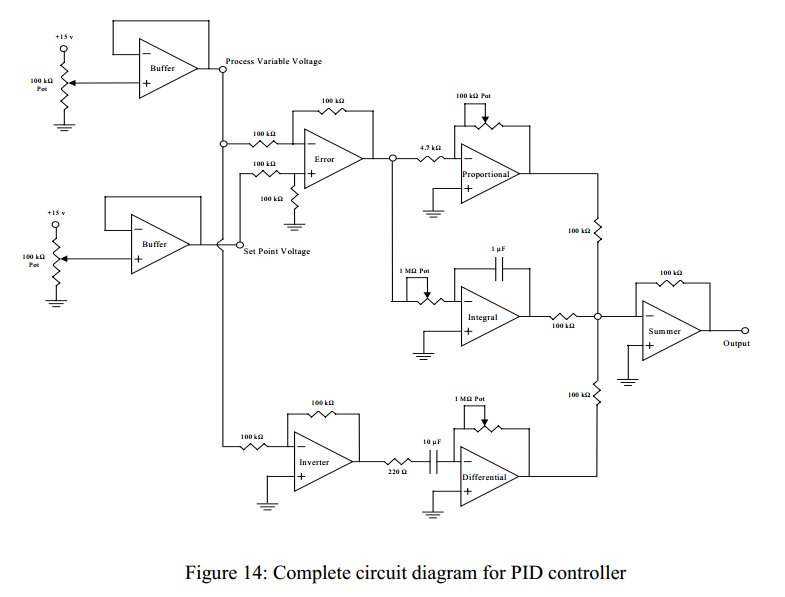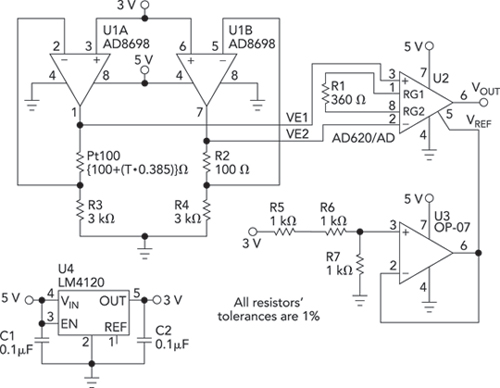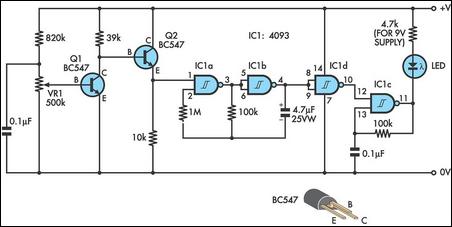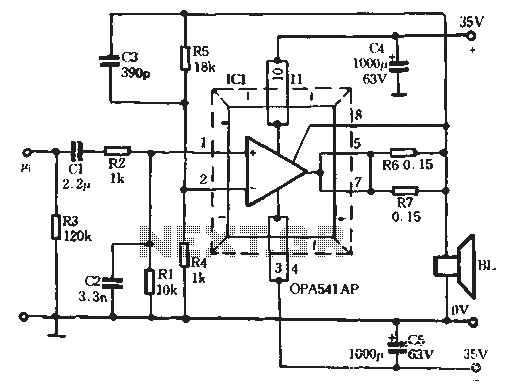
VOX Circuit
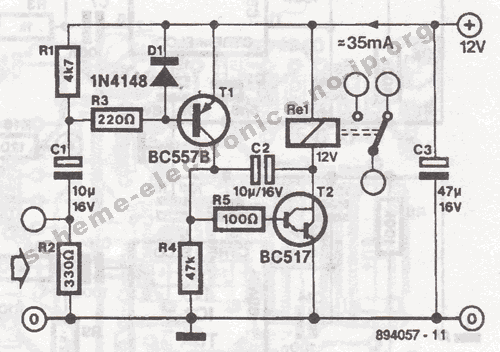
VOX is a voice-activated switch commonly used with microphones as an alternative to traditional push-button switches. The VOX can be connected to various audio equipment featuring an external speaker for coupling. The activation threshold is adjusted using the volume potentiometer of the audio amplifier that controls the VOX. The signal from the terminals of R2 connects capacitively to the base of transistor T1. Resistor R3 limits the base current of the transistor when the input voltage exceeds 600mV. Diode D1 prevents the positive trip of the input signal from allowing Veb to drop below 0.6V. The output circuit is controlled by the Darlington transistor T2. Resistor R4 keeps the relay unactivated while T1 is in a non-conducting state. The bipolar capacitor C2 functions as a filter in conjunction with T2. Resistor R5 limits the base current of T2 to a safe level. The switching threshold of the VOX is approximately 600mV (R2), and the maximum allowable input voltage is determined by the maximum power dissipation across R2 and R3, typically not exceeding 40V. The current consumption of the VOX is primarily the sum of the relay coil currents and R5. In cases of VOX overload, the resistance may rise to 100mA.
The VOX circuit operates as a voice-activated switch, utilizing a combination of transistors, resistors, capacitors, and diodes to achieve its functionality. The input signal is first processed through the volume potentiometer, which sets the desired activation threshold. When the audio signal exceeds this threshold (typically around 600mV), it triggers the base of transistor T1, allowing current to flow. The role of resistor R3 is critical as it ensures that excessive input voltages do not damage T1 by limiting the base current.
Diode D1 serves a protective function by clamping the input signal, ensuring that the voltage across the emitter-base junction (Veb) of T1 does not drop below 0.6V. This helps maintain the transistor in an active state when necessary and prevents false triggering from noise or low-level signals.
The Darlington pair configuration of T2 amplifies the current to drive the relay, which serves as the output actuator of the VOX circuit. Resistor R4 plays an essential role in keeping the relay deactivated when T1 is not conducting, ensuring that the circuit remains stable during idle periods. The use of capacitor C2 in the circuit allows for filtering, smoothing out any fluctuations in the output signal, which is critical for maintaining consistent performance in audio applications.
Resistor R5 is strategically placed to limit the base current flowing into T2, providing an additional layer of protection against overcurrent conditions that could damage the transistor. The overall design of the VOX circuit ensures that it can handle a maximum input voltage of 40V, with a current consumption that can reach up to 100mA during overload conditions. This comprehensive design allows the VOX to function effectively in various audio equipment setups, providing reliable and responsive voice activation.VOX is a switch ordered by voice, often used at microphones instead of the classic switch button. The vox described here may be connected to almost any type of audio equipment which has an external speaker for coupling. The threshold action is set with volume potentiometer of the audio amplifier which commands the VOX. The signal (on speakerphone) from the terminals of R2 is connected capacitive on T1 base. Resistance R3 limits base current of the transistor, in cases in which voltage input exceeds 600mV. Diode D1 hangs positive trip of the input signal, so Veb can not become less than 0. 6V. Relay form the output circuit is ordered by Darlingtonul T2. Resistance R4 maintains the relay unoperated as long as T1 is blocked. The bipolar capacitor C2 allows to work as filter together with T2. Resistance R5 is limiting the T2 current base at a security level. The threshold of switching VOX`s is about 600mV (R2). Maximum input voltage is determined by maximum admissible dissipation on R2 and R3. As a rule entry tension should not exceed 40Vvv. VOX consumed current is primarily formed by the sum of relay coil currents and R5. At VOX`s overloading, the resistance may lead up to 100mA. 🔗 External reference
The VOX circuit operates as a voice-activated switch, utilizing a combination of transistors, resistors, capacitors, and diodes to achieve its functionality. The input signal is first processed through the volume potentiometer, which sets the desired activation threshold. When the audio signal exceeds this threshold (typically around 600mV), it triggers the base of transistor T1, allowing current to flow. The role of resistor R3 is critical as it ensures that excessive input voltages do not damage T1 by limiting the base current.
Diode D1 serves a protective function by clamping the input signal, ensuring that the voltage across the emitter-base junction (Veb) of T1 does not drop below 0.6V. This helps maintain the transistor in an active state when necessary and prevents false triggering from noise or low-level signals.
The Darlington pair configuration of T2 amplifies the current to drive the relay, which serves as the output actuator of the VOX circuit. Resistor R4 plays an essential role in keeping the relay deactivated when T1 is not conducting, ensuring that the circuit remains stable during idle periods. The use of capacitor C2 in the circuit allows for filtering, smoothing out any fluctuations in the output signal, which is critical for maintaining consistent performance in audio applications.
Resistor R5 is strategically placed to limit the base current flowing into T2, providing an additional layer of protection against overcurrent conditions that could damage the transistor. The overall design of the VOX circuit ensures that it can handle a maximum input voltage of 40V, with a current consumption that can reach up to 100mA during overload conditions. This comprehensive design allows the VOX to function effectively in various audio equipment setups, providing reliable and responsive voice activation.VOX is a switch ordered by voice, often used at microphones instead of the classic switch button. The vox described here may be connected to almost any type of audio equipment which has an external speaker for coupling. The threshold action is set with volume potentiometer of the audio amplifier which commands the VOX. The signal (on speakerphone) from the terminals of R2 is connected capacitive on T1 base. Resistance R3 limits base current of the transistor, in cases in which voltage input exceeds 600mV. Diode D1 hangs positive trip of the input signal, so Veb can not become less than 0. 6V. Relay form the output circuit is ordered by Darlingtonul T2. Resistance R4 maintains the relay unoperated as long as T1 is blocked. The bipolar capacitor C2 allows to work as filter together with T2. Resistance R5 is limiting the T2 current base at a security level. The threshold of switching VOX`s is about 600mV (R2). Maximum input voltage is determined by maximum admissible dissipation on R2 and R3. As a rule entry tension should not exceed 40Vvv. VOX consumed current is primarily formed by the sum of relay coil currents and R5. At VOX`s overloading, the resistance may lead up to 100mA. 🔗 External reference
